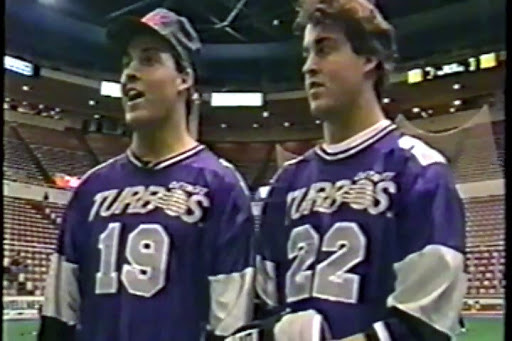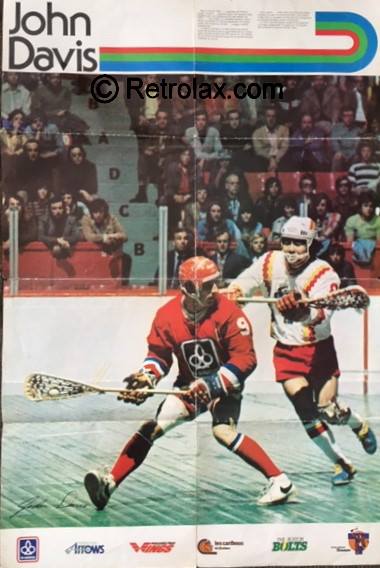NLL and MILL join forces. New league has at least eight teams, including Syracuse.
By LINDSAY KRAMER- The Post-Standard (7/23/1997)

The two competing professional lacrosse leagues have decided it’s better to develop their sport together than to perhaps damage it by staying apart.
The new National Lacrosse League and the 11-year-old Major Indoor Lacrosse League have reached an agreement to join forces starting in January 1998.
A revamped National Lacrosse League will open with at least eight teams, including three individually owned by the founders of the MILL.
Each league maintained it could have succeeded independently of each other. But the deal shifts their time and energy away from competing against each other and puts it toward better expansion and marketing of the sport.
Under the agreement, MILL president Russ Cline, CEO Chris Fritz and executive vice president Bruce Lucker will own NLL teams in Philadelphia, Hamilton and New York, respectively.
The MILL also is moving in its Washington/Baltimore franchise, although an owner still needs to be found.
NLL investors Howard Dolgon, Steve Donner and Frank DuRoss will own teams in Syracuse, Rochester and New England, respectively. Niagara Frontier Hockey, which owns the Buffalo Sabres, also will own an NLL team in Buffalo.
Expansion to Miami, Tampa Bay, Montreal and Ottawa is possible this season or next.

Cline said the deal wasn’t a case of the MILL surrendering, even though that league gives up its name and power structure.
He thinks the sport needs a fresh start and believes the preservation of familiar teams is more important than the name of the league.
“Everybody is a winner,” Cline said. “We have confidence in these guys (the NLL investors) and they have confidence in us.
The thing that made this possible was not a situation of need. It was a situation of what is best financially and best for the interest of the sport.”
Ronald L. Jaros, general counsel for the players union, has pushed for a compromise. Although two leagues gives the players more leverage, he thinks it also poses a divisive threat to the sport.
“On balance, it (a merger) is the better thing to have happen,” Jaros said. “I believe that what is good for the future of professional lacrosse is what’s good for the players.”
As recently as two weeks ago, the leagues were skeptical of each other and a compromise seemed unlikely. But Donner said there were two turning points that brought them together.

The first was an initial meeting between Fritz and DuRoss July 9 in Buffalo. Donner said that broke the ice in what had been a chilly relationship between the leagues.
The second was a gathering of MILL and NLL officials July 16 and 17 in Washington, D.C. Donner said the meeting started with both sides stressing their independence.
Cline then said everyone wants to see a deal work, but that the NLL had to give the MILL a chance to be a good partner. To do that, the NLL had to offer a fair deal that showed it trusted the MILL. The NLL investors then were given a chance to talk among themselves.
“We literally took a step back and thought about it,” Donner said. “We really felt it was sort of a defining moment.”
Donner, DuRoss and Dolgon returned from their time alone with a cautious but earnest attitude. The two sides took straw votes on several key issues and discovered they agreed on more than they had thought.
“That was important that we established a level of comfort and confidence with each other,” Dolgon said. “Once that happened, it was pretty easy sailing from then on in. When we sat down we realized ,.. we all wanted a strong league.”

The merger brings the strengths of both sides to bear on the sport as a whole. Among the benefits are:
Stability and continuity: The MILL has more than a decade of experience in running its league. Some of the NLL teams might keep their MILL nicknames, providing a link to the old league.
There was the possibility of the MILL and the NLL competing in several markets. That would have confused the sport’s already spotty fan base and strained the entertainment dollar.
“I think we both saw we had been spending a lot of time, energy and money not only promoting lacrosse but working against each other,” Donner said.
Increased sponsorship: Donner said the MILL is bringing national sponsorship deals that could be worth $500,000 to the new league.
A bigger footprint: The NLL had hoped to start with six to 10 teams. Now, it will debut with eight to 12. That will permit an expanded schedule and playoffs.
Fewer expansion risks: Donner said had the NLL started alone, it could have brought in some other cities that may be better off waiting a year to start.
“We can center in on taking the pressure off some of these markets,” he said. “It allows them to come in more prepared with a better chance of success.”
Better connections: Dolgon, Donner and DuRoss all operate American Hockey League teams and have several pro sports contacts.
Donner said his group has talked with the NBA’s Detroit Pistons and Miami Heat and the NHL’s Tampa Bay Lightning, Montreal Canadiens, Ottawa Senators, Pittsburgh Penguins, Toronto Maple Leafs and New York Rangers about owning NLL teams in their markets.

Increased television exposure:
t’s sure to be greater than that of the MILL. The MILL produced a weekly highlights package for ESPN. The NLL wants live game coverage.
“I want to see a kid watching a team play in Dallas, Texas, and say, ‘That’s where I want to play when I grow up,’ ” said Paul Gait, a former MILL star who has signed a plaver/consultant contract with the NLL.
Familiarity and confidence at the top of the sport. Donner and the Buffalo Sabres formerly operated MILL teams.
Dolgon and the MILL met last summer to talk about putting a franchise from that league here.
There are several more issues for the league to hammer out.
It needs to negotiate a collective bargaining agreement with its players, pick a commissioner and work out its schedule, among many other tasks.
Gait doesn’t think there will be any lingering bad feelings.
“Business is business,” he said.
“They’ll get along if they have to. They’re all smart people. They’ll make sure egos won’t get in the way from this point on.”







